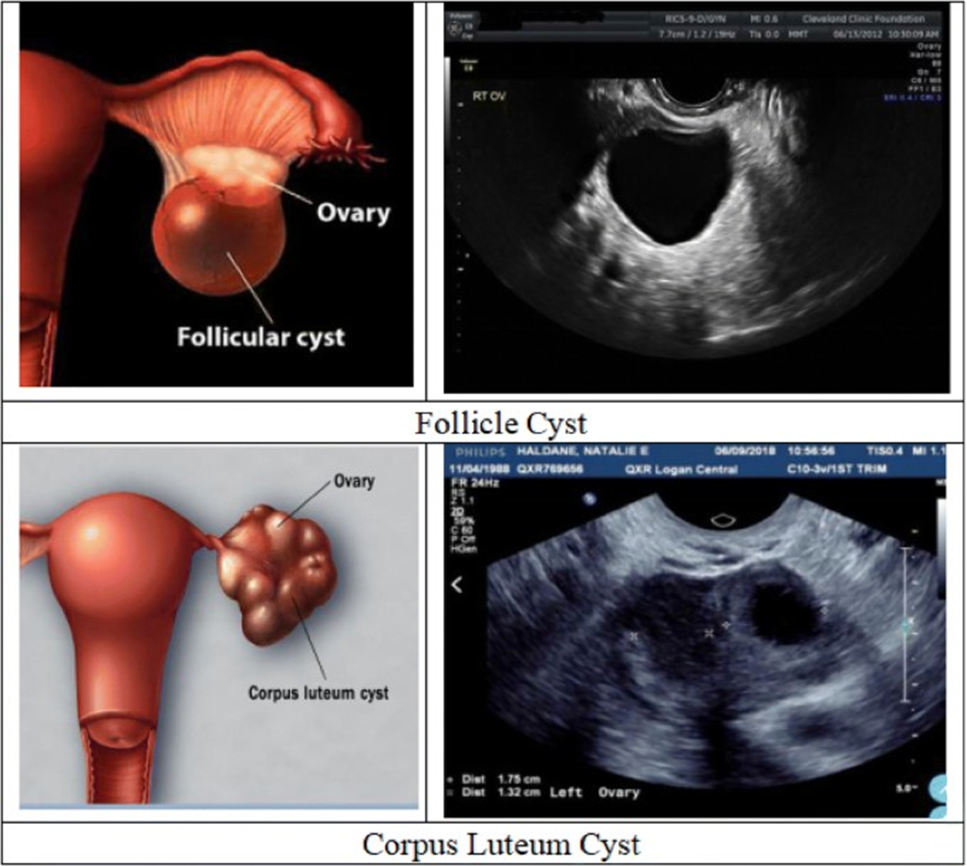A nurse is caring for a 22-year-old female client who is experiencing lower abdominal pelvic pain. The client is at risk of developing a condition due to a finding.
Condition: Ovarian cysts, Finding: Ultrasound shows a fluid-filled sac in the ovary.
Condition: Appendicitis, Finding: Pain localized in the lower right quadrant.
Condition: Endometriosis, Finding: Patient reports cyclical pain.
Condition: Pelvic inflammatory disease, Finding: Elevated white blood cell count.
The Correct Answer is A
Choice A rationale:
Ovarian cysts are fluid-filled sacs that form on or within an ovary. They are a common condition, affecting up to 1 in 5 women at some point in their lives. While most ovarian cysts are benign (non-cancerous), they can sometimes cause symptoms, including pelvic pain.
Ultrasound is a common imaging test that uses sound waves to create pictures of internal organs. It can be used to detect ovarian cysts, which often appear as fluid-filled sacs on the ovary.
The presence of an ovarian cyst on ultrasound, combined with the patient's symptoms of lower abdominal pelvic pain, suggests that the patient is at risk of developing complications from the cyst. These complications can include: Rupture: A ruptured ovarian cyst can cause sudden, severe pain and bleeding.
Torsion: This is when a cyst twists on its stalk, cutting off its blood supply. Torsion can also cause severe pain and may require emergency surgery.

Choice B rationale:
Appendicitis is an inflammation of the appendix, a small, finger-shaped organ located in the lower right abdomen. It is a common cause of abdominal pain, especially in young adults.
However, the patient in this scenario is experiencing pain in the lower abdominal pelvic region, not specifically in the lower right quadrant. This makes appendicitis less likely.
Additionally, the patient does not have any other symptoms that are typically associated with appendicitis, such as fever, nausea, or vomiting.
Choice C rationale:
Endometriosis is a condition in which tissue that normally lines the uterus grows outside of the uterus. It can cause pain, especially during menstruation.
However, the patient in this scenario does not report cyclical pain, which is a hallmark symptom of endometriosis. Additionally, endometriosis is not typically associated with the presence of fluid-filled sacs on the ovaries.
Choice D rationale:
Pelvic inflammatory disease (PID) is an infection of the upper genital tract, including the uterus, fallopian tubes, and ovaries. It is often caused by sexually transmitted infections (STIs).
PID can cause pelvic pain, but it is also typically associated with other symptoms, such as fever, vaginal discharge, and irregular bleeding.
The patient in this scenario does not have any of these other symptoms, and her white blood cell count is not elevated, which makes PID less likely.
Nursing Test Bank
Naxlex Comprehensive Predictor Exams
Related Questions
Correct Answer is D
Explanation
The correct answer is Choice D.
Choice A rationale: The client's age, being 20 years old, is not a contraindication to the use of a diaphragm. Diaphragms can be used by individuals of reproductive age, provided there are no other contraindications.
Choice B rationale: Having a vaginal birth 6 months ago is not a contraindication to using a diaphragm. The diaphragm's fit may need adjustment, but it can still be used safely postpartum.
Choice C rationale: Smoking cigarettes is a risk factor for several health conditions but is not a specific contraindication for the use of a diaphragm. However, smoking cessation should be encouraged for overall health benefits.
Choice D rationale: Having more than one sex partner increases the risk of sexually transmitted infections (STIs). Diaphragms do not protect against STIs, making it important to use condoms in conjunction with the diaphragm for clients with multiple sex partners.
Correct Answer is B
Explanation
Choice A rationale:
A blood pressure of 100/60 is within the normal range and does not pose a contraindication to oral contraceptives. While hypertension (high blood pressure) can be a contraindication, a blood pressure of 100/60 is not considered hypertensive.
However, it's essential to monitor blood pressure regularly in individuals using oral contraceptives, as some may experience a slight increase in blood pressure.
Choice B rationale:
Age is a significant factor when considering oral contraceptive use.
Adolescents under 16 years of age are generally not recommended to use oral contraceptives due to several concerns: Their reproductive systems are still developing, and hormonal contraceptives could potentially disrupt normal growth and development.
Younger adolescents may have more difficulty adhering to a strict daily medication regimen, which is crucial for the effectiveness of oral contraceptives.
They may be at a higher risk of certain side effects, such as irregular bleeding patterns and mood changes.
Acne treatment is often a primary reason for considering oral contraceptives in adolescents. However, alternative acne treatments that are more suitable for younger individuals are available.
Choice C rationale:
A hematocrit of 39 is within the normal range for females and does not contraindicate oral contraceptive use.
Hematocrit measures the proportion of red blood cells in the blood. Oral contraceptives can sometimes cause slight changes in hematocrit levels, but these changes are typically not clinically significant.
Choice D rationale:
A menstrual cycle of 14 days is considered a normal variation and does not pose a contraindication to oral contraceptives. Oral contraceptives can often regulate irregular menstrual cycles, so they may even be beneficial for individuals with shorter or longer cycles.
Whether you are a student looking to ace your exams or a practicing nurse seeking to enhance your expertise , our nursing education contents will empower you with the confidence and competence to make a difference in the lives of patients and become a respected leader in the healthcare field.
Visit Naxlex, invest in your future and unlock endless possibilities with our unparalleled nursing education contents today
Report Wrong Answer on the Current Question
Do you disagree with the answer? If yes, what is your expected answer? Explain.
Kindly be descriptive with the issue you are facing.
